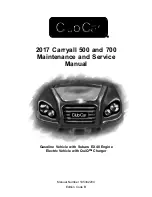
Workman GTX Gasoline
Drive Train
Page 4
−
5
Primary Clutch Operation
The operation of the primary clutch is affected by engine
shaft speed. When the engine is off and not turning, the
drive belt rests low within the primary clutch sheaves as
the clutch sheaves are spaced apart. As the engine is
started and increases in speed, the clutch rollers move
outward as they spin about the engine drive shaft. The
outward movement of the rollers against the spider as-
sembly forces the moveable sheave closer to the sta-
tionary sheave. This inward movement of the moveable
sheave engages the drive belt which begins to rotate.
With increasing engine speed, the moveable sheave
continues to move inward. This sheave movement
forces the drive belt to ride towards the outer diameter
of the primary clutch sheaves which increases the drive
belt speed.
When engine speed is decreased, the rollers exert less
force on the moveable sheave. The reduced force
causes the moveable sheave to shift away from the sta-
tionary sheave and slows the drive belt speed. As en-
gine speed continues to decrease, the drive belt
disengages from the clutch sheaves.
The primary clutch controls moveable sheave operation
with six (6) weighted rollers and ramp surfaces in the
moveable sheave.
1. Stationary
sheave
2. Moveable
sheave
3. Spider
assembly
4. Cover
5. Roller (6 used)
Figure 2
5
4
3
2
1
Secondary Clutch Operation
The operation of the secondary clutch is affected by
transaxle load. When the vehicle is stopped, the drive
belt is held at the outer diameter of the secondary clutch
sheaves from the pressure of the spring pushing the
moveable sheave against the stationary sheave and
away from the fixed cam.
Once the drive belt starts rotating, the secondary clutch
also starts to rotate. With increasing speed of the prima-
ry clutch, the drive belt begins to climb to the outer diam-
eter of the primary clutch sheaves. This increases the
tension on the drive belt, and forces the moveable
sheave of the secondary clutch to move away from the
stationary sheave against the pressure of the spring. As
the belt tightens and the sheaves open up, the drive belt
rides lower in the secondary clutch sheaves.
With increased load to the transaxle, the fixed cam re-
sists forward movement relative to the moveable
sheave and drive belt. Torque from the drive belt and
spring pressure moves the moveable sheave up the
ramp of the fixed cam. The drive belt becomes posi-
tioned closer to the outer diameter of the secondary
clutch sheaves.
A fixed cam on the secondary clutch moveable sheave
rotates on a pair of rollers in the stationary sheave base
to allow low friction movement of the moveable sheave.
1. Moveable
sheave
2. Stationary
sheave
3. Spring
Figure 3
2
1
3
Drive T
rain
Summary of Contents for Workman GTX
Page 1: ...Form No 16224SL Rev C Workman GTX Gasoline Original Instructions EN ...
Page 4: ...NOTES _ ...
Page 6: ...Workman GTX Gasoline This page is intentionally blank ...
Page 8: ...Workman GTX Gasoline This page is intentionally blank ...
Page 16: ...0 09375 Workman GTX Page 2 2 Product Records and Maintenance Equivalents and Conversions ...
Page 42: ...Workman GTX Gasoline Page 3 22 Gasoline Engine This page is intentionally blank ...
Page 57: ...Workman GTX Gasoline Drive Train Page 4 15 This page is intentionally blank Drive Train ...
Page 63: ...Workman GTX Gasoline Drive Train Page 4 21 This page is intentionally blank Drive Train ...
Page 72: ...Workman GTX Gasoline Drive Train Page 4 30 This page is intentionally blank ...
Page 112: ...Workman GTX Gasoline Page 5 40 Electrical System This page is intentionally blank ...
Page 162: ...Page 6 50 Workman GTX Gasoline Chassis This page is intentionally blank ...
































